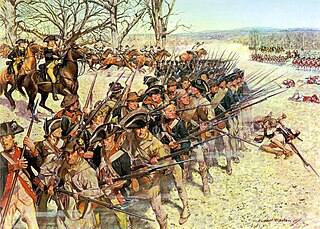
The Battle of Guilford Court House was on March 15, 1781, during the American Revolutionary War, at a site that is now in Greensboro, the seat of Guilford County, North Carolina. A 2,100-man British force under the command of Lieutenant General Charles Cornwallis defeated Major General Nathanael Greene's 4,500 Americans. The British Army, however, suffered considerable casualties.
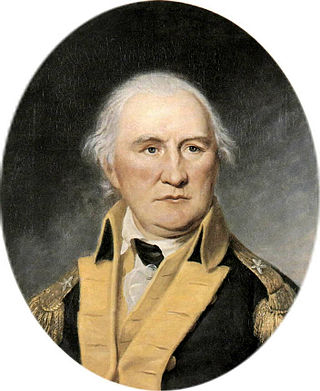
Daniel Morgan was an American pioneer, soldier, and politician from Virginia. One of the most respected battlefield tacticians of the American Revolutionary War of 1775–1783, he later commanded troops during the suppression of the Whiskey Rebellion of 1791–1794.

The Battle of Camden, also known as the Battle of Camden Court House, was a major victory for the British in the Southern theater of the American Revolutionary War. On August 16, 1780, British forces under Lieutenant General Charles, Lord Cornwallis routed the numerically superior American forces led by Major General Horatio Gates about four miles north of Camden, South Carolina, thus strengthening the British hold on the Carolinas following the capture of Charleston.
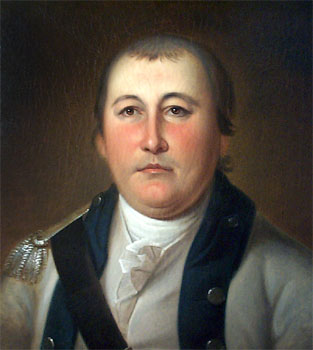
William Washington was a cavalry officer of the Continental Army during the American Revolutionary War, who held a final rank of brigadier general in the newly created United States after the war. Primarily known as a commander of light dragoons, he led mounted troops in a number of notable battles in the Carolinas during the campaigns of 1780 and 1781.

Sir Banastre Tarleton, 1st Baronet was a British general and politician. He is best known as the lieutenant colonel leading the British Legion at the end of the American Revolution. He later served in Portugal and held commands in Ireland and England. Consequently, he had hoped to command British forces fighting the French in the Peninsular War. However, that position was given to Arthur Wellesley.

The Battle of Kings Mountain was a military engagement between Patriot and Loyalist militias in South Carolina during the Southern Campaign of the American Revolutionary War, resulting in a decisive victory for the Patriots. The battle took place on October 7, 1780, 9 miles (14 km) south of the present-day town of Kings Mountain, North Carolina. In what is now rural Cherokee County, South Carolina, the Patriot militia defeated the Loyalist militia commanded by British Major Patrick Ferguson of the 71st Foot. The battle has been described as "the war's largest all-American fight".

The British Legion was an elite British provincial regiment established during the American Revolutionary War, composed of Loyalist American troops, organized as infantry and cavalry, plus a detachment from the 16th Light Dragoons. The unit was commonly known as Tarleton's Legion, after the British officer who led it on campaign, Lieutenant Colonel Banastre Tarleton. It was a unit the size of a regiment, consisting of artillery, cavalry, and light infantry, and able to operate independently.

Edward Carrington was an American soldier and statesman from Virginia. During the American Revolutionary War he became a lieutenant colonel of artillery in the Continental Army. He distinguished himself as quartermaster general in General Nathanael Greene’s southern campaign. He commanded artillery at Monmouth and Yorktown. He was also present at Cowpens, Guilford Court House, and Hobkirk's Hill. During the war he became a close friend of George Washington. Carrington served in the 3rd Continental Congress and was the first US Marshal appointed from his state. He was an original member of the Society of the Cincinnati.

The Battle of Cowpens was an engagement during the American Revolutionary War fought on January 17, 1781 near the town of Cowpens, South Carolina, between American Patriot forces under Brigadier General Daniel Morgan and British forces, nearly half American Loyalists, under Lieutenant Colonel Banastre Tarleton, as part of the campaign in the Carolinas. The battle was a turning point in the American reconquest of South Carolina from the British.

The Battle of Waxhaws was a military engagement which took place on May 29, 1780 during the American Revolutionary War between a Patriot force led by Abraham Buford and a British force led by Banastre Tarleton near Lancaster, South Carolina. Buford's men consisted of Continental Army soldiers, while Tarleton's force was mostly made up of Loyalist troops. After the two forces sighted each other, Buford rejected an initial demand to surrender. Tarleton's cavalrymen launched a charge against the Patriot troops, which led many of Buford's men to throw their arms down in surrender. However, as Tarleton was shot under his horse during the charge, his infuriated soldiers attacked their Patriot opponents, killing several.
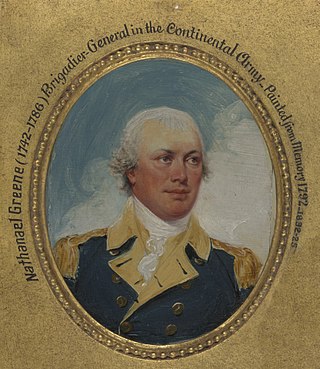
The Battle of Hobkirk's Hill was a battle of the American Revolutionary War fought on April 25, 1781, near Camden, South Carolina. A small American force under Nathanael Greene occupying Hobkirk's Hill, north of Camden, was attacked by British troops led by Francis Rawdon. After a fierce clash, Greene retreated, leaving Rawdon's smaller force in possession of the hill.
Pyle's Massacre,, was fought during the American Revolutionary War in present-day Alamance County on February 24, 1781. The battle was between Patriot troops attached to the Continental Army under Colonel Henry Lee and the Loyalist North Carolina militia commanded by Dr. John Pyle. Due to the unique uniform design of his forces, the Loyalists mistakenly thought Colonel Lee was the expected British cavalry commander, Banastre Tarleton, who was known to be en route to reinforce Pyle. When Lee's men opened fire, they took Pyle's force totally by surprise. This resulted in an extremely lopsided victory for Lee, and Pyle's command was scattered and routed.

The southern theater of the American Revolutionary War was the central theater of military operations in the second half of the American Revolutionary War, 1778–1781. It encompassed engagements primarily in Virginia, Georgia, North Carolina, and South Carolina. Tactics consisted of both strategic battles and guerrilla warfare.

The siege of Yorktown was the culminating act of the Yorktown campaign, a series of military operations occupying much of 1781 during the American Revolutionary War. The siege was a decisive Franco-American victory: after the surrender of British Lt. Gen. Charles, Earl Cornwallis on October 17, the government of Lord North fell, and its replacement entered into peace negotiations that resulted in British recognition of American independence with the 1783 Treaty of Paris.
The Battle of Cowan's Ford was a battle in the Southern Theater of Cornwallis's 1780–1782 Campaign that eventually led to the British Army's surrender at Yorktown during the American Revolutionary War. It was fought on February 1, 1781, at Cowan's ford on the Catawba River in northwestern Mecklenburg County, North Carolina, between a force of about 2,400 British and about 800 Whig militia who were attempting to slow the British advance across the river. The American general William Lee Davidson was killed in this battle.

The Battle of Ramsour's Mill took place on June 20, 1780 in present-day Lincolnton, North Carolina, during the British campaign to gain control of the southern colonies in the American Revolutionary War. The number of fighters on each side of the battle is still an issue of contention, but Loyalist militiamen outnumbered Patriot militia and had captured a group of Patriots who they were planning to hang on the morning of June 20.
The Battle of Monck's Corner was fought on April 14, 1780, outside the city of Charleston, South Carolina, which was under siege by British forces under the command of General Sir Henry Clinton in the American Revolutionary War. The Loyalist British Legion, under the command of Lieutenant Colonel Banastre Tarleton, surprised an American force stationed at Monck's Corner, and drove them away. The action cut off an avenue of escape for Benjamin Lincoln's besieged army. Aside from the British Legion, and the 33rd Foot and 64th Foot led by Lt. Col. James Webster, the force included Loyalists, the American Volunteers, led by Maj. Patrick Ferguson.
The Battle of Lenud's Ferry was a battle of the American Revolutionary War that was fought on May 6, 1780 in present-day Berkeley County, South Carolina. All of the British soldiers who took part in the Battle of Lenud's Ferry were in fact Loyalists who had been born and raised in the colony of South Carolina, with the sole exception being their commanding officer Banastre Tarleton. The unit was known as the Loyalist British Legion, under the command of Lieutenant Colonel Banastre Tarleton. The Loyalist British Legion scattered a company of Patriot militia at Lenud's Ferry, a crossing point on the Santee River, north of which lies present-day Georgetown County.

The Battle of Torrence's Tavern was a minor engagement of the American Revolutionary War that took place in what was the western portion of Rowan County, North Carolina, approximately 10 miles (16 km) east of the Catawba River near modern-day Mooresville in Iredell County. Torrence's Tavern was a part of the larger Southern campaign of the American Revolution, which, by 1780–1781 involved a series of clashes between the British Army and Loyalist militia and the Continental Army and Patriot militia in the Piedmont region of North and South Carolina.
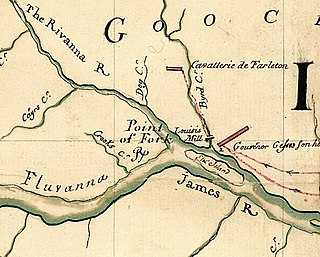
Point of Fork Arsenal was an arsenal established in the 18th century located near what is now Columbia, Virginia, United States. It was raided and destroyed on June 5, 1781, by Col. John Graves Simcoe of the Queen's Rangers. It was rebuilt and used for the manufacture and repair of arms and supplied material to combat the Whiskey Rebellion and to aid the Battle of Fallen Timbers. The arsenal remained in service until 1801, when it was abandoned in favor of a more centralized arsenal at Richmond, the Virginia Manufactory of Arms.













